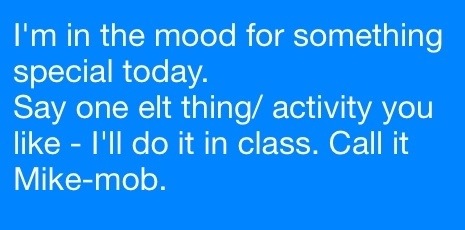I’m happy you’ve found the title intriguing enough to check this post. It’s going to be about love, hate and #FlashMobELT Movement.
First, think about an activity you can use (or have already been using, maybe) in your classroom, which:
- requires the use of students’ English skills to speak about things which they probably don’t know very well
- imitates real life (in certain ways)
- allows students to learn what their mates think about something
- asks them to come up with ideas on the spur of the moment
- challenges them to speak about something without preparation
- has them speak for a limited amount of time (30 sec-1 min) without a stop
- makes them retrieve a huge/ small amount of words they’ve rarely/ never used before
- lets them think about the pluses and minuses of something
- brings them to think about something they haven’t given a thought before
- leads them to argument the stated position
- offers them a chance to think of alternatives to their ordinary opinions
- is stressful
- is not stressful
Well, this is how my students reflected on and described the LOVE/HATE activity we did last week. I picked the activity from the #FlashmobELT lino wall and you can still find it there, on a blue sticky note, signed by @michaelegriffin. That’s what it tells a teacher to do:
… have students in pairs and have one student talk for a certain amount of time (30 seconds or a minute) about why they LOVE or HATE a certain thing. This certain thing is written on the board by the teacher. The tricky thing is that the students have to decide if they will be saying they love or hate the thing before they hear what it is. When the word appears students have to speak immediately and hopefully this is a nice challenge…
 Photo of a student’s notebook
Photo of a student’s notebook
I had to clarify though that it has to be a monologue, as students kept interrupting their speaking partners to ask questions or express their opinion. then, after each minute they had to report very briefly what reasons for hating/ loving had been mentioned. That part was exceptionally good as everybody got to hear all of the reasons and in the end we had a pool of pros&cons about this Something. Or Somebody. By the way, I’m still not sure if it is a reasonable idea to include people in the list of possible words to write (like I did with Bolt and Messi). In one of the students’ feedback sheets I found a line saying it was not a good idea to talk about people, because not everybody knows much about these people. To be honest, I can’t agree this is a sufficient reason as I am very demanding towards students’ basic scope. On the other hand, I wouldn’t like my students to criticize people. When I put myself in their shoes, I don’t even want to think of possible arguments to hate Messi, not because I’m his fan but simply because it doesn’t seem right to me. However, it was fun, in practice 🙂
It seems to be worth giving students time to tell their truth after doing Love/ Hate. I didn’t really listen to my students’ real opinions about any of the words, but the funniest thing is that nobody even felt eager to share them. So maybe as long as you follow the flow of the activity and watch as it’s developing, notice students’ reactions, you can make your own decisions on what else can be done.
It’s my strong conviction that there’s always something that you try to do in a class and it sticks to your teaching, and there’s always something that you try and it’s good and seems efficient but just doesn’t feel “yours”. Well, Love/ Hate surely feels mine! I actually did it with four groups during last week, their levels varying from Low Pre-Intermediate to Upper-Intermediate. We used it as a lead-in activity into new vocabulary topics as well as a pre-reading task for the text. And every time it went down a storm.
This post marks the week anniversary of our baby #FlashMobELT Movement. It’s still fun and simple – go to the Lino wall, pick an activity that suits your objective, your class, your mood for the day. Take it into your classroom. Enjoy it and then share how it went. Join in!
You can also read reports about #FlashmobELT used at the lessons here:
Kevin Stein on how he joined his first movement in Joining My First Movement (#FlashMobELT, go go go)
The #FlashmobELT Movement post announcing the birth of it and offering you a brief summary of the first activity I used.
Here’s also the video that scientifically proves why you can’t possibly hate Usain Bolt. He’s wicked fast.
